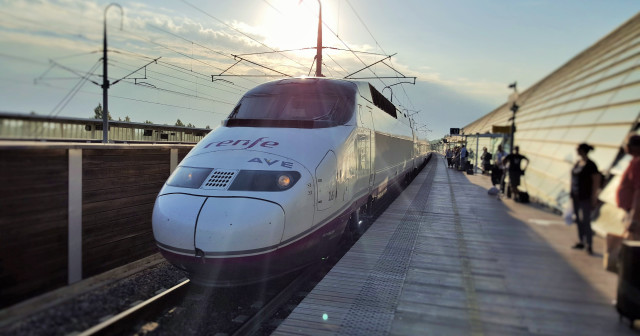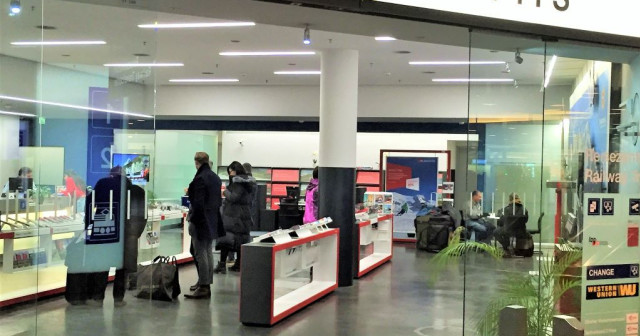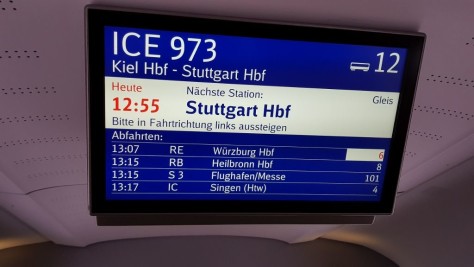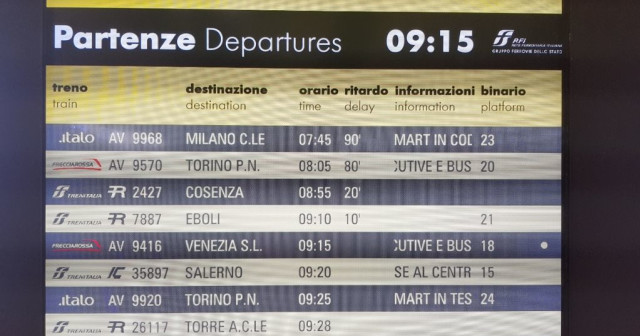Traveling to Europe with kids? What to know about vaccination and entry rules
How to travel by train in Europe
Want to take a new European train journey and not sure how? This beginner’s guide can help make that idea a reality, as it’s a gateway to a wealth of info compiled over the past four years!
Share
One of the things which inspired the creation of ShowMeTheJourney is the gap between those who say they want to go by train and those that actually go ahead and make a journey.
So this guide will help remove concerns about how to get from A to B by train in the 15 European countries which have the highest number of rail travellers.
It’s packed with links to fairly detailed explanations of those aspects of train travel which can be confusing, such as how to buy train tickets, find trains at stations and discovering if a train can take you where you want to go.
But this beginner’s guide to European train travel will also show you how to make the most of the journey, by using the on-board facilities and seeing the best of the scenery.
The core idea is to show you that taking a new European train journey can be much easier than you think it would be.
Though the many quirks around European train travel have had to be included too and explaining them can require a weight of text, but that knowledge is key to understanding the wonders of European travel.
Smarter and faster trains, easier to use stations, more direct routes and simpler online ticket booking, all contribute to this Golden Age of European Rail Travel, so now you can discover it for yourself.
How easy will your journey be
If you’re considering a rail journey the first thing you need to know is whether you can get there by train.
Because the goal of train travel providers is to make money, direct trains are typically available if you’ll be trying to travel from one city to another that’s less than 150km / 100 miles in distance; and many trains inevitably cover much longer-distances.
Europe’s main railway routes have always been planned so that the dominant cities in a country can be connected as quickly as possible, but this also means that capital cities can be similar to spokes in a wheel, from which railway lines fan out across a nation.
This is the case when travelling to and from London, Paris, Madrid, Prague, Budapest and Stockholm, meaning that rail journeys across country are less frequent but they are possible.
In other countries, cities other than the capital have become the hubs of railway networks, including Frankfurt in Germany; Milan and Bologna in Italy; and Zurich in Switzerland.
Many railways across Europe have also been built with tourists front of mind, or have survived because of the access they provide to dramatic landscapes.
Hence it’s possible to take trains to, from and within beautiful locations such as the Swiss Alps, the Scottish Highlands, The Black Forest, Wales and pretty much anywhere on the Mediterranean Sea’s northern coastline.
You can look for journey guides to taking more than 1000 of most popular rail routes using the search box below.
The guides show whether a journey is direct, requires connections, how frequent the trains depart, how long the journey will take and what to look out for when booking tickets.
They feature easy access to useful info on the stations and trains, plus links to the multiple agents which sell tickets for the journey online; and on the scenic routes there are tips for making the most of the journey.
- Austria by train
- Innsbruck
- Salzburg
- Wien / Vienna
- Belgium by train
- Bruxelles / Brussels
- Czechia by train
- Praha / Prague / Prag
- Denmark by train
- København / Copenhagen
- France by train
- Lille
- Lyon
- Marseille
- Paris
- Germany by train
- Berlin
- Frankfurt (Main)
- Hamburg
- Köln / Cologne / Koeln
- München / Munich
- Great Britain by train
- Edinburgh
- Glasgow
- London
- Manchester
- Hungary by train
- Budapest
- Italy by train
- Bologna
- Firenze / Florence
- Milano / Milan / Mailand
- Roma / Rome
- Torino / Turin
- Venezia / Venice / Venedig
- Verona
- Netherlands by train
- Amsterdam
- Norway by train
- Oslo
- Poland by train
- Warszawa / Warsaw
- Spain by train
- Barcelona
- Madrid
- Sweden by train
- Stockholm
- Switzerland by train
- Basel / Bâle
- Bern
- Genève / Geneva
- Zürich / Zurich
- No Matching Cities
- List is empty.
- No Matching Cities
- List is empty.
Making connections
Taking direct trains isn’t always an option due to geography or quirks of railway history, but this doesn’t have be a barrier to making a rail journey.
The railway networks of Austria, Switzerland and The Netherlands function like giant metro systems, with simple as can be connections between trains.
What can be a tad trickier are the longer journeys by express trains, which can require seemingly random connections.
When buying tickets for such journeys, the ticket agents tend to assume that you’ll want to reach a final destination in the fastest possible time, but that can involve making connections against the clock; and yes this is best avoided.
One of my golden rules is to always allow more than 30 minutes to make a connection between trains, because it typically makes an end-to-end journey less stressful.
More often than not ticket agents don’t sell tickets for journeys which involve a risk to a traveller losing out financially, in the event of missed connections, due to delays to a preceding train.
Though having to visit a travel desk mid-journey to rearrange tickets and reservations on subsequent trains is a scenario best avoided.
So three tips to avoid it:
- On the advance search options on many booking services its possible to set a minimum connecting time between trains, so set it to at least 30 minutes.
- If you’re given a choice of end-to-end journey options with connections, don’t choose the final option of the day, set off earlier and give yourself more contingency time in the event of delays.
- Book separate tickets for each part of a journey and give yourself three hours or more to see something of the city, where you will be making a connection, between trains. Drop your bags in the left-luggage and set off exploring, or have a long lunch in a restaurant in or near the station.
How to travel
Having established that a train can take you to your destination, you can decide how you are going to make the journey, because on most European trains first and second class will be available.
On express trains in first class ,the seats are always larger and the space between them is greater in comparison to second class, so the core idea is that the journey will be more comfortable, the more you pay for your ticket.
Though whether you choose first or second makes little difference to the ticket booking.
Typically the different types of ticket will be available for travel in first or second; and how the tickets can be used is dictated by the type of ticket and not which class you have chosen to travel by,
However, in Germany if you book first class tickets for a journey by an express, IC, or ICE train, you will have a complimentary seat reservation.
If you won’t be travelling long-distance, so will be taking a regional train, the difference between second and first class can seem marginal, but what you are partially paying for by booking first class tickets, is a higher possibility of finding available seats when travelling on trains on which reservations are not available, or are optional.
Travelling in first class is also the only means of accessing these travel benefits; when they are available on a route:

- Travelling in single seat with no other traveller beside you; the seats in the first class areas on most European express trains are arranged 1 + 2 across the aisle.
- Access to passenger lounges at stations; though in some countries including France, these are now only accessible to bookers of the equivalent of Business Class tickets.
- Not having to leave your seat in order to obtain hot food.
The first class travel experience can vary significantly depending on the specific train service that you will be travelling by, with the key difference being the catering service which will or won’t be available to first class passengers at their seats.
It ranges from a complimentary meal, similar to what would be served in a restaurant car on the train, to no at-seat service at all.
Less obvious benefits of travelling first class can include:
- More space in which to store luggage
- Access to enhanced Wi-Fi
- More power sockets, including USB sockets
- An increase likelihood of being sat at a table.
First Class travel on European trains Is First Class worth it on European trains is a commonly asked question. Though due to the varieties of enhanced comfort and on board service, it doesn’t have a definitive answer, but more often than not, it will be a yes.
First Class travel on European trains Is First Class worth it on European trains is a commonly asked question. Though due to the varieties.
European Daytime Trains: A Beginner’s Guide the on board facilities of more than 70 European train services; check the catering, whether you can take bikes and what’s available in 1st class
European Daytime Trains: A Beginner’s Guide the on board facilities of more than 70 European train services; check the catering, whether you can.
A quick guide to train tickets
There are two core paths to take to obtaining tickets for your rail journey:
(1) booking walk-up tickets at the station just before boarding;
(2) booking online before you head to the station.
Travellers can be wary of booking at stations because the ticket counter staff may not speak English, but two tips around this are:
- give the ticket machines a try, those you’ll find at major stations generally have excellent multi-lingual translations.
- look up a journey, using the tips below, and take the info, the departure times and train number to the ticket desk; don’t worry about what a train number is, that’s explained further down the page.
The core reason for making the effort to book online is to save money, because if you want to take an express train service, no matter the distance, it’s more than likely that discounted tickets will be placed on sale; and the further ahead you book, the cheaper they will be.
Train journeys in Belgium and The Netherlands are exceptions.
You can also book these discounted tickets at the Advance travel desks at major stations, but to make the biggest savings you typically have to book weeks ahead.
In contrast tickets for local and regional trains are hardly ever discounted, so usually you won’t lose out if you book them just before hopping on board.
Direct regional trains can travel long-distances such as Roma ↔ Firenze/Florence; Lyon ↔ Marseille and Munche/Munich ↔ Salzburg.
if you will be buying walk up tickets at the station, regional services such as these, are often cheaper than travelling by the express trains.
An Introduction To Buying Tickets for European Train Journeys The key things worth being aware of when buying tickets for European train journeys, including step-by-step guides to booking tickets online.
An Introduction To Buying Tickets for European Train Journeys The key things worth being aware of when buying tickets for European train journeys, including step-.
Checking train times
So the suggestion above was to buy tickets for journeys by local and regional trains at the station, so this nugget of advice will seem a tad bizarre.
Because before heading to the station it’s a good idea to check the times of the departures to your destination, more often than not, this is most easily done by looking up a journey on a ticket booking service.
Many of them now have a check train-times functionality.
Most European countries offer train journey planning and timetables apps and online services; you’ll find links to them on the country guides.
Online ‘departure boards’ are also available for most main stations and if a station has one, you’ll find a link to it on the station guides.
A frequent longer-distance express or regional rail service in Europe would comprise a train every hour, and a frequent local service would be a train every 30-60 minutes.
This level of frequency is typical across Belgium, Switzerland and The Netherlands, and is also found away from the rural areas of Austria, Denmark, Germany, Great Britain, Hungary and Italy.
Though countries in which the timetables are less regular include France, Norway, Poland, Spain and Sweden.
Why it matters in which country you’ll be travelling
One of the odder aspects of European train travel is the variations between how rail journeys can be taken in each country.
All European countries either have a dominant government funded national rail operator, or a state managed organisation which oversees its railways, and they set the ‘rules’ around travel.
So each country has it own policy around multiple aspects of travelling by train, which include, but are not limited to:
-
tickets are placed on sale.
- The T&Cs around the refund and exchange of train tickets.
- The seat reservation policy on express trains.
- What extras you will and won’t receive on board if you book First Class tickets
- The T&Cs for child tickets.
- How to travel on trains with a non-folding bicycle.
- How to travel on trains with a dog.
- The T&Cs for using rail passes such as Eurail and InterRail.
- Whether railcards which save money on tickets will be available.
Of course if you’re only making some journeys by train in Italy you won’t need to know the ‘rules’ around taking bikes on trains in France. However, if you’re a regular traveller by train in your home European country, it’s easy to assume that what you know about buying train tickets etc will also apply in another country, but it won’t.
Hence the guides to travelling by trains in these 15 countries on the buttons below, will be worth the 10 mins of your time that it will take to read them; and more of them will be added soon.
- Austria by train
- Innsbruck
- Salzburg
- Wien / Vienna
- Belgium by train
- Bruxelles / Brussels
- Czechia by train
- Praha / Prague / Prag
- Denmark by train
- København / Copenhagen
- France by train
- Lille
- Lyon
- Marseille
- Paris
- Germany by train
- Berlin
- Frankfurt (Main)
- Hamburg
- Köln / Cologne / Koeln
- München / Munich
- Great Britain by train
- Edinburgh
- Glasgow
- London
- Manchester
- Hungary by train
- Budapest
- Italy by train
- Bologna
- Firenze / Florence
- Milano / Milan / Mailand
- Roma / Rome
- Torino / Turin
- Venezia / Venice / Venedig
- Verona
- Netherlands by train
- Amsterdam
- Norway by train
- Oslo
- Poland by train
- Warszawa / Warsaw
- Spain by train
- Barcelona
- Madrid
- Sweden by train
- Stockholm
- Switzerland by train
- Basel / Bâle
- Bern
- Genève / Geneva
- Zürich / Zurich
- No Matching Cities
- List is empty.
- No Matching Cities
- List is empty.
Know your stations
This may be No.1 on the most potentially confusing aspects of European train travel, as many major cities have more than one station used by long-distance trains.
This matters both when booking tickets; travelling to one station can be cheaper than another; and when you’re on the train you need to know where to leave it.
Hence the journey guides show how to take trains from and to the main stations in each city and they also point out the alternative station options.
It can be a good idea to check the locations of the start and finish points of your end-to-end journey on Google Maps and seeing either, which are the nearest main stations, or which have the easiest public transport connections.
Larger cities including Budapest, Paris, London and Madrid have no main central station, but instead have multiple stations on the edge of their central area, serving trains which head off in different directions.
The use of word resembling ‘Central’ in a station name means that the station will indeed be the main city centre station, but not all stations follow this pattern.
In Austria and Germany the main city centre stations are known as hauptbahnhofs, which is often shortened to ‘hbf’; in Czechia ‘hln’ is used and in Poland the main stations are ‘glowny.
Other main city stations can be named after a local landmark, a local area, or named in honor of an individual, hence these being some of the less obvious names of main city centre stations:
- Barcelona Sants
- Birmingham New Street
- Edinburgh Waverley
- Firenze Santa Maria Novella (Florence)
- Marseille St Charles
- Roma Termini (Rome)
- Venezia Santa Lucia (Venice)
- Verona Porta Nuova
The language of train travel
The info is showing the next station call and the connections which will be available
Taking a new train journey requires the taking on of information, buying the appropriate ticket, finding the train at a station and working out when to leave it etc.
Therefore many would be travellers have concerns that they will be able to understand this info in a foreign land.
However, most of the info that rail traveller’s need is presented visually on the departure screens at stations and increasingly on displays within the train.
Also many announcements at stations and on board trains are in both the native language and English, though France is an exception to this.
But train travel itself has a unique vocabulary and it inevitably gets used all over ShowMeTheJourney, including this guide.
So if you’re confused by what is meant by reservations, train numbers, rail passes etc, check out the guide below.
The Language of Train Travel This guide to the vocabulary of European train travel helps explain the terms and phrases you may see at stations, on timetables and on websites
The Language of Train Travel This guide to the vocabulary of European train travel helps explain the terms and phrases you may se.
Finding your train:
Like many European station departure boards, this one at Zurich’s main station only shows the main calling points of each train
The major stations of Europe can be awe-inspiring, but they can also be tricky to navigate, partially because they weren’t designed with once in a lifetime travellers front of mind, hence many of them feature multiple entrances and short-cuts, to make life easy for their daily users.
Some of them also have multiple parts, used by different train services, and some of these different areas of a station can be some distance from the main entrance.
Other stations are akin to layers of cake, with some of the trains leaving from parts of the station above ground, with others using subterranean parts of the station, even though they are not metros.
These multi-dimensional stations, of both types described above, include: Antwerpen Centraal, Berlin Hbf, Bern, Bologna Centrale, Bruxelles-Midi; London St Pancras International, Madrid Atocha, Manchester Piccadilly, Munchen Hbf, Paris Gare De Lyon, Paris Montparnasse, Roma Termini, Wien Hbf and Zurich HB.
So if you already have a ticket it can be a good idea to be at a major station for the first time a minimum of 15 mins before your train departs
If you will joining a train at city station where it’s commencing a journey and don’t have a reservation, add on another 15mins, so that you can be among the first to board when your train’s departure details are confirmed.
If you’ll be buying a ticket at station allow 30 mins to make a purchase to allow for queues at both ticket counters and ticket machines.
Add on another 20 mins to all of the above timings, if you’ll want to buy a coffee etc before heading to the train, this last minute food/drink purchasing can be more complicated that you might assume.
If you will be taking a Eurostar, or a high-speed train in Spain or a Thalys train service, also factor in the check-in times / security procedures.
Heading to the train
You will be likely relying on the visual info at the station to find the train you’ll be taking, because these days the details of departures are rarely announced.
So you’ll need to use two types of visual info, one of which will tell you the platform/track etc you will need to head to; and the other will tell you how to make your way to it.
Most of Europe’s large multi-level stations have elevators which give access to the trains if you have heavy luggage etc, but they can be out of sight, away from the most obvious routes to the departures.
So if you’ll want to use them don’t assume that they don’t exist because you can’t see them, look out for them on the station signage, or ask station staff.

Precisely how you find out which platform/track you need head to varies between counties, hence the guides to using stations below, plus the info you’ll find on the country guides, but the three key pieces of info, which will help identify the train you need to take, are:
(1) It’s departure time – if you will taking a local train so the time won’t be on the ticket, ask at the ticket counter what time it will be leaving.
(2) The final destination of the train – it will be either written in the language at the destination, or the local language of where you are; so look that info up before you head to the station, it can be super useful to know that Anvers = Antwerp; Firenze = Florence; Wien = Vienna etc.
This can matter because most of the main departure boards at European stations won’t show every station that the trains will be calling at; though Great Britain is an exception to this.
It’s why the final destination of the train is always included on the journey guides.
(3) Using train numbers – In Austria, France, Czechia, Germany, Italy, Poland, Spain and Sweden, the easiest method of finding your train on the departure board, is to match the train number on your ticket, to the corresponding numbers on the departure screens.
On this Italian departure board:
Train no. 2280 is leaving from platform 3 and Train no. 2129 is leaving from platform 4.
Train numbers for international trains can also be shown in countries where numbers aren’t used for the domestic services.
The key piece of information you’ll need to know is which platform / track your train will be leaving from.
Many European departure boards have multi-lingual headers which will show where to look for these platform/track details
Also don’t be surprised if when you first look at a board you see a blank space where the info should be, becasue it will suddenly appear as soon as it is confirmed.
Even without a translation it’s normally fairly easy to work out where to look, because its the column with the least info in it.
Though at stations, systems of letters can be used for each platform/track instead of numbers
Plus at most Dutch stations and some British stations, including Birmingham New St, Edinburgh Waverley and Leeds, you will see both a number + a letter; because the platforms are split into different sections indicated by the letters, and trains can depart from these specific sections.
Also in eastern Europe including in Poland and Croatia you may see two numbers, one of which is for the platform and the other is for the track, because the platform can be split into the equivalent of the quarters.
There’s no getting away from how confusing all of the above can be, but most major European stations have information desks at which you can check everything you need to know about how to find your train.
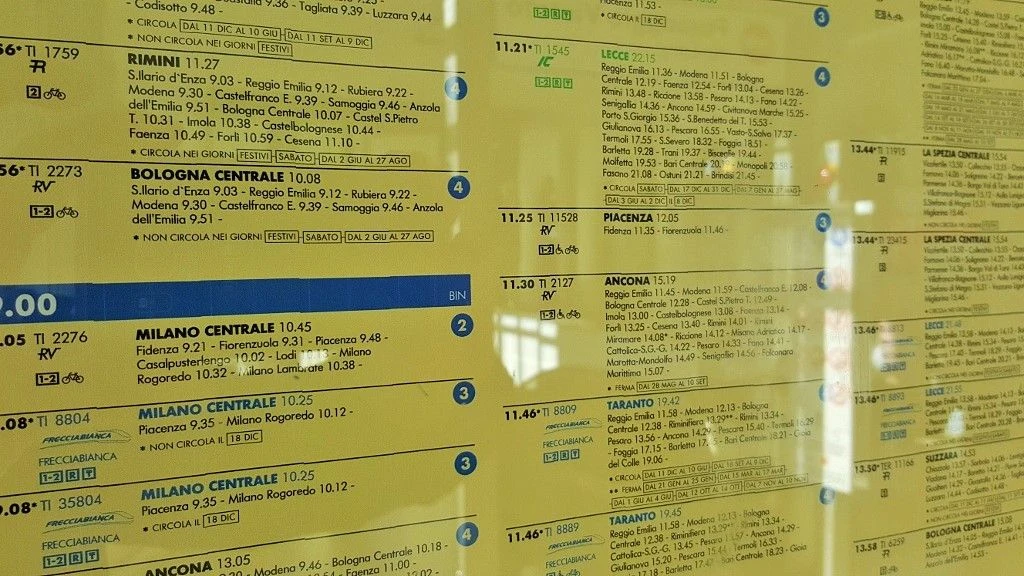
Though once you have ticket there is often an ol-skool method of working out where your train will/should be leaving from.
At stations in Austria, Belgium, Germany, Italy, Poland, Spain and Switzerland, there will be departure posters listing every train and they have the platform/track numbers on them.
Though if the info on the screens is different, follow that instead.
If you will be joining a train at an intermediate station, there will be other departure screens on the platform which show the details of the next train to be leaving from it.
So you can confirm you’re at the right place, but look twice because your train may not be the next to leave.
These screens can also show info that wasn’t on the main departure board, including all of the calling points and where to wait for easy boarding into 1st class, the on-board restaurant, or the bike spaces.
If you will be changing trains look out for any departure summary screens, when you step off the train.
Traveling to Europe with kids? What to know about vaccination and entry rules

Do children need a booster for travel in Europe this summer? Can unvaccinated children travel? Here’s what you need to know as the European Union (EU) introduces flexible travel rules for people under the age of 18.
Across the EU, tourists who completed their primary jabs more than 270 days ago need a booster to enter countries such as France, Spain and Italy — or be considered unvaccinated and therefore subject to additional rules such as testing.
This recommendation was introduced by the European Commission (the legal arm of the EU) on February 1 under the EU Digital COVID Certificate regulation. Most EU member states adopted it, though some, such as Ireland, Denmark and Sweden, have since scrapped all COVID-19 entry requirements at their borders.
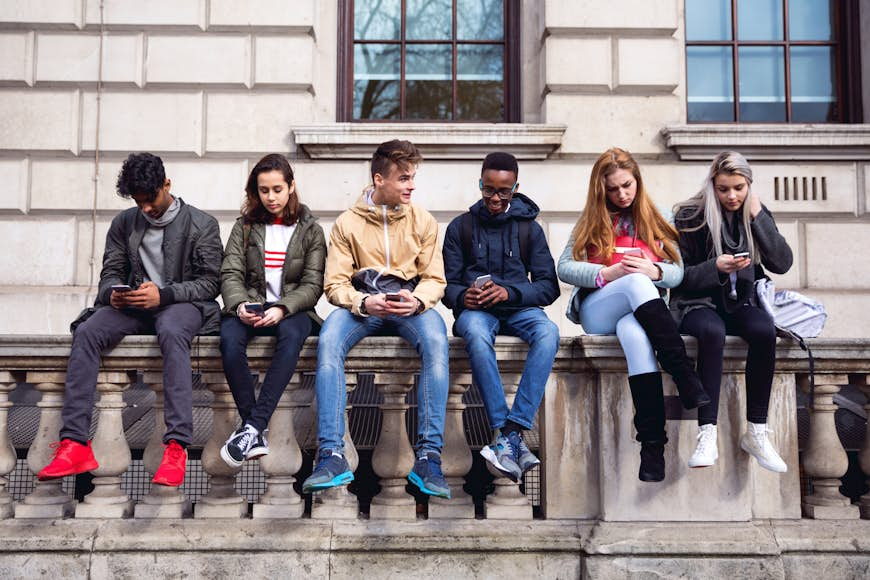
Children under the age of 18 are now considered fully vaccinated with the primary series of vaccines under the EU Digital COVID Certificate © Getty Images
This week, the Commission introduced new rules on the EU digital COVID certificate that exempt children under the age of 18 from the 270 days acceptance period following the primary vaccination series. This means that children are considered fully vaccinated after having received their primary dose; whether that’s a two-shot vaccine series or a one-shot Johnson & Johnson vaccine.
By April 6, this new feature will be included in the mobile app used to verify EU Digital COVID Certificates so that children’s certificates remain active without the booster.
In a statement, Commissioner for Justice, Didier Reynders, said: “One of the biggest benefits of the EU Digital COVID Certificate is its flexibility to adapt to new circumstances. Following discussions with member states’ public health experts, we have decided that the vaccination certificates of minors should not expire. When travelling, they will be able to continue using the certificate received after the primary series of vaccination.”
This exemption applies to EU and Schengen Zone citizens and residents traveling within Europe, though some countries can adopt their own entry restrictions regardless of the Commission’s ruling.
If you plan to travel to Europe with kids this summer, here’s what you need to know about the latest entry rules and how they apply to you, even if you’re traveling from countries outside of the EU like the UK and the US.
Can unvaccinated children travel to Europe?
Generally speaking, yes. Children under 12 are typically exempt from vaccination requirements in most countries but many require that children between the age of 12 and 18 have received the primary vaccine course to avoid testing rules.
What countries in Europe have scrapped COVID-19 entry restrictions?
Andorra, Denmark, Hungary, Lithuania, Iceland, Ireland, Montenegro, Norway, Poland, Romania, Slovenia, Sweden, and the United Kingdom have recently dropped all pandemic restrictions at their borders, meaning people no longer have to show vaccination certificates or negative tests to enter these countries, regardless of where they are coming from.

Countries in Europe with travel restrictions
Here are some of the destinations in Europe that still require proof of vaccination, recovery or a negative test from travelers.
Austria
People over the age of 12 need one of the following: proof of vaccination (boosters mandatory 270 days after primary vaccine course); a recovery certificate (issued within the past 180 days); or a negative PCR (72 hours) or antigen (24 hours) test.
Boosters are not required for those under 18 to be considered fully vaccinated.
Belgium
Generally, people traveling from the EU/Schengen area can present proof of vaccination (booster mandatory 270 days after primary vaccine course); a recovery certificate (issued within the past 180 days) or a negative PCR (72 hours) or antigen (36 hours) test.
People from outside the EU or an area categorized as high-risk must present proof of vaccination. Children under 18 can present proof of recovery or a negative test. Children under 12 are exempt.
Belgium’s rules vary depending on the COVID-19 risk associated with your departing country.
Croatia
People need one of the following: proof of vaccination (boosters mandatory 270 days after primary vaccine course); a recovery certificate (issued within the past 180 days); or a negative PCR (72 hours) or antigen (24 hours) test.
Children under the age of 12 are exempt from testing. Boosters are not required for those under 18 to be considered fully vaccinated.
Cyprus
People over the age of 12 need one of the following: proof of vaccination (booster mandatory seven months after primary vaccine course) or a negative PCR (72 hours) or antigen (24 hours) test. People also have to take a PCR on arrival and isolate while awaiting results.
Children under the age of 12 are exempt from testing. Boosters are not required for those under 18 to be considered fully vaccinated.
Estonia
People must present proof of vaccination (boosters mandatory nine months after primary vaccine course) or recovery certificate (issued within the past 180 days) to bypass additional restrictions. Unvaccinated travelers from the EU and approved countries including the UK and US must isolate for seven days upon arrival.
Children under the age of 12 are exempt from entry rules.
Germany
People traveling from the EU, Schengen Zone or approved countries including Hong Kong, New Zealand and South Korea can present one of the following: proof of vaccination; recovery certificate (older than 28 days, but no less than three months old) or a PCR (48 hours) or antigen (48 hours) test. Children under the age of 12 are exempt from testing.
People traveling from outside the EU, including the UK and the US, must be vaccinated to enter Germany. Unvaccinated 6-11 year olds can enter with a vaccinated parent; unvaccinated accompanying over-12s can provide a negative PCR or antigen test.
Greece
People traveling from the EU, US, UK, Canada, Australia, and other approved countries need to present one of the following: proof of vaccination (boosters mandatory seven months after primary vaccine course); a recovery certificate (issued within the past 180 days); or a negative PCR (72 hours) or antigen (24 hours) test.
Children under five are exempt from all entry requirements. Boosters are not required for those under 18 to be considered fully vaccinated.
Finland
There are no entry rules for those traveling from the EU and Schengen Zone countries. However, people coming from third countries such as the UK and the US must provide proof of vaccination (boosters mandatory nine months after primary vaccine course) or recovery certificate (issued within the past six months).
Children born in 2007 or later are exempt if accompanied by a fully vaccinated adult.
France
People must present one of the following: proof of vaccination (boosters mandatory nine months after a primary vaccine course) or a negative PCR (72 hours) or antigen (48 hours) test.
Children under 12 are exempt. Boosters are not required for those under 18 to be considered fully vaccinated.

Italy
People need to present one of the following: proof of vaccination (boosters mandatory seven months after primary vaccine course); a recovery certificate (issued within the past 180 days); or a negative PCR (72 hours) or antigen (48 hours) test.
Children under the age of six are exempt from testing. Boosters are not required for those under 18 to be considered fully vaccinated.
Latvia
People over the age of 12 need one of the following: proof of vaccination (second dose administered at least 14 days prior to travel); recovery certificate; or negative PCR (72 hours) or antigen (48 hours) test.
Luxembourg
People need one of the following: proof of vaccination (boosters mandatory nine months after primary vaccine course); a recovery certificate (issued within the past six months); or a negative PCR (48 hours) or antigen (24 hours) test.
Children under the age of 12 are exempt.
Malta
People must present proof of vaccination with a booster to travel to Malta.
Children between the ages of five and 11 must present a negative PCR test (72 hours). Children under five are exempt.
Netherlands
There are no entry rules for people traveling from the EU/Schengen area or countries participating in the EU travel rules scheme. People from elsewhere, including the US and UK, must present proof of vaccination (boosters mandatory 270 days after primary vaccine course) or a recovery certificate (issued within the past 180 days but no earlier than 11 days).
Children under 12 traveling to the Netherlands from outside the EU/Schengen area must show a negative PCR (48 hours) or antigen (24 hours) test.
Portugal
People over the age of 12 need one of the following: proof of vaccination (boosters mandatory 270 days after primary vaccine course); a recovery certificate (issued within the past 180 days); or a negative PCR (72 hours) or antigen (24 hours) test.
Boosters are not required for those under 18 to be considered fully vaccinated.
Slovakia
People traveling to Slovakia must show proof of vaccination (boosters mandatory nine months after primary vaccine course).
Children under the age of 12 are exempt.
Spain
People traveling from the EU can show proof of vaccination (boosters mandatory nine months after primary vaccine course); a recovery certificate (issued within the past 180 days) or a negative PCR (72 hours) or antigen (24 hours) test.
People traveling from outside the EU must show proof of vaccination or recovery only (unless traveling to Balearic Islands where proof of vaccination is mandatory).
Children under 12 are exempt from vaccination requirements. Unvaccinated 12 to 17-year-olds can present a negative PCR (72 hours) test.
Switzerland
People traveling to Switzerland must show proof of vaccination ( booster mandatory 270 days after primary vaccine course) or a recovery certificate (issued within the past 180 days).
Children under 18 are exempt.
Turkey
Most people need to present one of the following: proof of vaccination; a recovery certificate (issued within the past six months but no less than 28 days); or a negative PCR (72 hours) or antigen (48 hours) test.
Children under the age of 12 are exempting from testing.
People from high-risk countries are subject to stricter rules including quarantine if they’re unvaccinated.
Buy Where to go When Europe

With more than 300 suggestions for destinations across Europe and the best time of year to experience them, this book is the ultimate trip planner for every month of the year.
Buy Where to go When Europe

With more than 300 suggestions for destinations across Europe and the best time of year to experience them, this book is the ultimate trip planner for every month of the year.
Explore related stories
A reason to travel to Bergamo and Brescia in 2023: Italy’s new capitals of culture
Hit early and hard at the start of the COVID-19 pandemic, these cities have been chosen as a symbol of renaissance, hope and rebirth through culture.
20 incredible places to visit in Ireland beyond the Cliffs of Moher
Ireland’s rich culture, friendly locals and incredible natural scenery promise a trip of a lifetime. Make sure you get to these 21 best places to visit.
A reason to travel to Hauts-de-France in 2023: Europe’s new region of gastronomy
Perfect for a gourmet getaway: this northernmost region of France was awarded the European Region of Gastronomy 2023.
The 10 best road trips in Ireland
With epic coastlines, lush countryside, charming villages and buzzing cities, Ireland is a joy to explore. Here are the 10 best road trips in Ireland.
Car, bike or public transport? How best to get around in Ireland
The big decision in getting around Ireland is whether to go by car or use public transport. Here’s our handy guide to find what’s right for your trip.
What to eat and drink in Italy
One of the world’s most revered cuisines, Italian food is a handy umbrella term for the country’s cache of regional cuisines.
Where to eat and drink in Spain
Food and wine are national obsessions in Spain, and rightly so. From tapas to wine, jamón to paella, here are the best Spanish dishes and where to try them.
The best hikes in Italy explore Alpine highs and Amalfi skies
From the cliff-hanging trails of Amalfi to the colossal granite spires of the Dolomites, Italy is made for hiking.
What You Need to Travel to Europe in 2023
With Europe now open to international visitors, many travelers are looking forward to taking their first trip in 2022. However, overseas travel is different since COVID-19, and there will be more changes to European entry requirements in the future.
This brief guide explains what you need to travel to Europe in 2022, including visas and COVID-19 documents.
Remember that entry restrictions and requirements are being updated regularly. Make sure you have all the latest information before arranging travel to Europe.

Passports and Entry Permits to Travel to Europe
Pre-pandemic, there was one key document to travel to Europe—a valid passport.
If you’re an American or Canadian citizen, you can enter the Schengen Area with just a passport and explore 26 countries for up to 90 days visa-free. This remains the same despite COVID-19. However, you’ll also need the additional COVID-19 documentation explained below.
Europe’s Entry Requirements for Americans, Canadians, and other visa-exempt countries will change
Europe’s entry requirements for Americans, Canadians, and other visa-exempt countries will change at the end of this year. You’ll soon need an electronic travel authorization called ETIAS to visit European destinations.
The exact launch date has not yet been announced. It was originally slated to go into effect in late 2022. However, the European Union has postponed the launch of the European Travel Information and Authorization System (ETIAS) to November 2023. There’ll be a short implementation period before the visa waiver becomes mandatory to travel to Europe visa-free on an American or Canadian passport.
It’s important to point out that this is not a visa. The new permit is similar to the United States ESTA, you’ll be able to register online in a few minutes. To find out if you’re eligible, check here.
Passport holders from other countries still require a Schengen visa for their vacations in Europe. Visas are also required for stays of over 90 days.
Vaccine Certificates to Travel to Europe
The European Union recommends that Member States progressively reopen to international travel. According to EU guidelines, people fully vaccinated with vaccines authorized by the European Medicines Agency (EMA) should be able to visit Europe for any purpose, including on vacation.
Although each Member State is responsible for its borders and sets its own entry restrictions, many countries follow these rules. Favorite European tourist destinations such as Spain and Italy are now open to tourists from around the world.
Vaccines approved by the EMA are Comirnaty (BioNTech and Pfizer), Nuvaxovid (Novavax), Spikevax (Modern), Vaxzevria (AstraZeneca), and COVID-19 Vaccine Janssen.
Several EU Member States also accept vaccines approved for emergency use by the World Health Organization (WHO).
Your vaccination certificate must include the type of vaccine received and the dates of each dose. Other key information includes the country where the vaccines were administered and the certificate issuing authority.
It’s important to check the specific vaccine certificate requirements for the country you want to visit. In particular, the accepted vaccines and how many days before travel you need to have received the last dose (usually 14).
Some countries accept a recovery certificate instead of proof of vaccination. A vaccine passport is required to enter some public spaces in Europe. In Spain, you’ll need to show a valid document to enter restaurants.

Passenger Locator Forms
This document goes by several names: passenger locator form, travel health certificate, electronic health declaration, etc. Many European countries now require passengers to fill out an online form before departure.
This form allows nations to screen visitors for health risks before they cross the border. It also facilitates contact tracing. You’ll typically have to provide information about your recent travel history and where you will stay during your visit. Contact information is also requested.
Travel health forms must be submitted 48 to 72 hours before arrival. Where required, you’ll need to present the QR code or pass before boarding a flight to your destination.
European countries with obligatory passenger locator forms in 2022 include Belgium, Croatia, France, Greece, Portugal, and Spain, amongst others. If you plan to visit more than one country on your trip to Europe, be aware that a different travel health certificate is required for each country.

COVID-19 Test Results to Travel to Europe
The document you may need to travel to Europe in 2022 is a COVID-19 test certificate showing a negative result.
Whether you need a COVID-19 test for Europe depends on your vaccination status and the country you are visiting. You don’t need a pre-departure test to visit countries including Latvia and Spain if you’re fully vaccinated.
If you need a test to travel you must check the type of test required (for example, PCR or antigen), and soon before departure you should take the test.
A test certificate showing the date and time of the test, the type of test carried out, and where the certificate was issued is essential.

Europe 2022 Document Checklist
To summarize the requirements explained above, here is a checklist of what you may need to travel to Europe this year:
- Valid passport
- ETIAS visa waiver (from late 2022)
- Schengen visa or another relevant visa (from non-exempt countries)
- COVID-19 vaccination certificate (or recovery document)
- Passenger locator form
- Negative COVID-19 test result
Despite the additional requirements, Europe is accessible to tourists in 2022. Just allow extra time to arrange your documents, and always double-check the latest requirements.
Go World Travel Magazine is a digital magazine for world travelers. Each week, we bring you new travel videos, articles and travel tips on destinations in more than 90 countries.
Source https://showmethejourney.com/travel-info-and-tips/how-to-travel-by-train-in-europe/
Source https://www.lonelyplanet.com/news/latest-europe-travel-rules-for-children-under-18
Source https://www.goworldtravel.com/what-you-need-travel-europe-2022/

